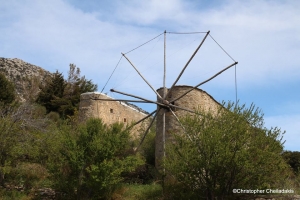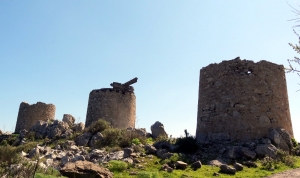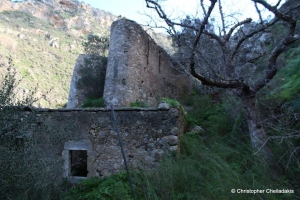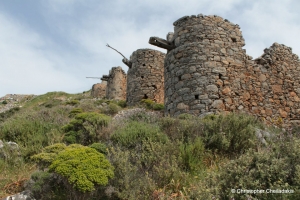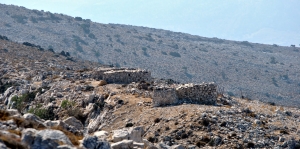The villages Ano Pines and Kato Pines hosted two separate sites with windmills. The first site is located at the area called 'Paliomili' high above the villages. The second is located at position Vorina near the village Kato Pines, with incredible views of the lagoon of Elounda.
At the village Koxari near Heraklion we meet a very nice and short trail, ideal for a short walk in nature and a little getaway not far from the city. This trail starts through the narrow streets of the village and moves to the south till the spring of Mesa Vrissi which gives life to the small valley of Koxari. The entire route is in the shade of the plane trees and the oak trees alternating throughout the route with orange, walnut and other fruit trees.
Within walking distance from the ruined village Argiro Nero, between the villages Zenia and Exo Potami we meet the small cluster of windmills of Katakalou. The mills are located in the same residential complex of Katakalou among vineyards and orchards. The mills operated after the destruction of the larger mill park of Zaroma, west of Mesa Potami.
Just a few meters out of the village Gonies at province Malevizi, on the road that leads to the beautiful village Kamaraki with the two wonderful caves, we meet Paliomylos (Old Mill). The Paliomylos is one of the many mills that once decorated the ravines of the island
South of Harasso, we still meet one small windmill park of Crete. There are still standing three windmills in a row. These mills are of the rarer type of mills in Crete: the completely circular, turning to all winds, called Xetrocharis. They were used for grinding grain.
Only a few meters south of the stone bridge of Astraki we find the stunning watermill of Paterikos, preserved in very good condition and it is of the very few mills that existed in Crete and were double, meaning that the carried through the stone channels was divided into two different fall-towers and so. correspondingly, there were two different rotors for moving the millstones.
North of Fourni village, Merambelo district, we still meet one of the most impressive windmill park of Crete. There are still standing 13 windmills in a row at location Galaropetra. Others survive in good condition and others have collapsed.
At this point there is a rough unknown windmill group that consisted of 10 mills and operated until May 1867. In these mills, local chieftains had gathered their wounded men during the titanic ten-day battle of Lassithi.













